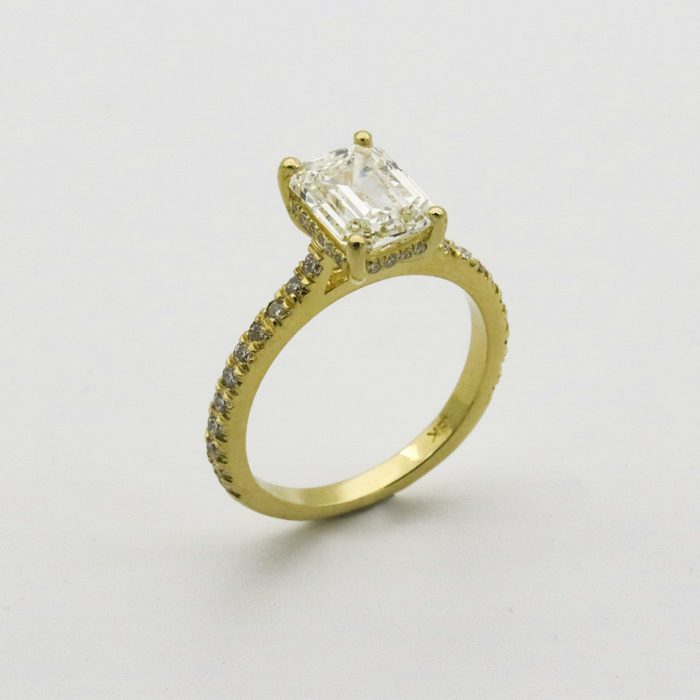Regarding gold rings, buyers frequently need help to strike the ideal mix between variety and quality. They must determine which of the several varieties of Gold is best for them or what fits within their price range. Since ancient times, people have valued Gold as a representation of riches, extravagance, and ageless beauty due to its inherent value and timeless appeal.
Many options are available for gold rings, ranging from distinct gold kinds to a wide array of shapes and styles. To assist you in selecting the ideal piece of jewelry, we will examine the characteristics and varieties of Gold used to produce rings in this post.
The essential characteristics of Gold
Before exploring the sorts of Gold used in rings, it is essential to comprehend the characteristics that make Gold a highly sought-after substance for jewelry:
- Purity: The purest type of Gold is 24 karats, measured in karats. Pure Gold (24 carats) is frequently alloyed with other metals to increase durability because it is too brittle for jewelry. Zinc, silver, and copper are common alloys. The proportion of alloyed metals increases with decreasing karat value. For instance, 14-karat gold is 58.3% pure, while 18-karat gold is 75% pure.
- Color: There are several hues of Gold, such as rose, white, and yellow. The alloy’s metal composition determines the color. While white Gold is produced by alloying Gold with white metals such as nickel or palladium, yellow Gold is the natural color of pure Gold. Rose gold is made by mixing copper into the alloy to give it a warm, pinkish tinge.
- Durability: The karat purity of Gold affects how long it lasts. Lower karat gold (14 karats) is more resilient and appropriate for daily wear, whereas higher karat gold (18 or 24 karats) is softer and more prone to scratches.
Kinds of Gold Used in Rings
Various types of Gold are frequently used to make gold rings. Since each variety has distinct qualities, selecting the one that best fits your requirements and preferences is critical. Here are some well-liked choices:
- Yellow Gold: Regarding rings, yellow Gold is the most conventional and classic option. Its rich, warm hue goes well with many skin tones, making it a classic and adaptable choice. In addition to being commonplace as daily accessories, yellow gold rings are popular as wedding and engagement bands.
- White Gold: Due to its sleek and contemporary design, it has become increasingly fashionable. White gold rings, made by combining yellow Gold with white metals like nickel or palladium, frequently have a rhodium plating applied to them to increase their brilliance. White Gold goes nicely with many gemstones and is an excellent match for a modern look.
- Rose Gold: Recently, it has gained popularity due to its romantic and feminine appeal. It is made by incorporating copper into the gold alloy, which gives it a warm, pinkish color. Rose gold rings give every jewelry collection a dash of originality and sophistication.
- Green Gold: The consequence of alloying gold with silver is that green gold is a unique but uncommon variety. With its faint greenish tint, this alloy offers a distinctive and earthy substitute for conventional gold tones.
- Black Hills Gold: The Black Hills region of the United States is the source of this particular sort of Gold. It is frequently identified by unusually arranged tri-colour gold leaves that are yellow, rose, and green. Black Hills gold rings’ artistry and symbolic design make them highly valued.
Selecting the Ideal Kind of Gold Ring for Yourself
There are a few crucial things to take into account while choosing the perfect type of gold ring for you:
- Personal Style: Take into account your tastes and style. Yellow Gold can be your best option if you value classic elegance. White Gold might be more appropriate for a sleek, modern style. Rose gold can be the ideal choice if you’re looking for a unique and romantic look.
- Skin Tone: A range of gold hues go well with different skin tones. White Gold can go well with colder undertones, but yellow Gold usually looks better on warmer undertones. Due to its warm color, rose Gold frequently complements various complexion tones.
- Occasion: Your decision for a gold ring may be influenced by the occasion. Traditional yellow Gold is a popular choice for engagement and wedding bands, although distinctive varieties, such as Black Hills gold, may be chosen because of their symbolic patterns.
- Gemstone Pairing: If your gold ring has stones, think about how the Gold’s hue accentuates the rocks. Diamonds, for example, go well with white Gold, while coloured gemstones can look especially striking against rose or yellow Gold.
Final Thoughts
Selecting the ideal gold ring entails knowing the characteristics and kinds of gold, considering your style, and assessing how the ring will fit into different areas of your life. Every form of gold adds something unique to the world of jewelry, whether you choose the classic appeal of yellow gold, the sleek modern elegance of white gold, or the romantic charm of rose gold.
Let your style, preferences, and occasion lead you to the gold rings that will become a treasured memento of timeless beauty and meaning as you begin choosing one.

